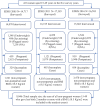Overweight and obesity trends and associated factors among reproductive women in Ethiopia
- PMID: 38863400
- PMCID: PMC11172244
- DOI: 10.1080/16549716.2024.2362728
Overweight and obesity trends and associated factors among reproductive women in Ethiopia
Abstract
Background: In low- and middle-income countries, the double burden of malnutrition is prevalent. Many countries in Africa are currently confronted with overweight and obesity, particularly among women, coupled with an increase in the prevalence of non-communicable diseases.
Objective: This study examines trends in overweight and obesity among Ethiopian women of reproductive age from 2005 to 2016, and identifies associated factors.
Methods: We used three consecutive datasets from 2005 (n = 14070), 2011 (n = 16515), and 2016 (n = 15683) demographic health survey years. Multilevel logistic regression was used to identify the determinant factors among individual- and cluster-level variables.
Results: The prevalence of overweight and obesity among reproductive women in Ethiopia increased steadily from 6.09% in 2005 to 8.54% in 2011, and 10.16% in 2016. However, mixed patterns were observed among the regions of the country. We found that age, education, living in urban areas, and living in a rich community are associated with becoming overweight and obese. For instance, the odds of becoming overweight and obese among women aged 35-49 were higher than those among women aged 15-24 (odds ratio [OR] = 3.62, 95% Confidence Interval [CI]:2.64-4.97). Women who completed secondary school have higher odds than those without formal education (OR = 1.64, 95% CI:1.19-2.26).
Conclusion: To our knowledge, this is the first study to investigate trends in the nationwide prevalence of overweight and obesity and the associated factors among Ethiopian women. This study warrants further follow-up research to identify the pathways between overweight and obesity and their probable factors.
Keywords: Ethiopia; Overweight; demographic and health survey; obesity; trend.
Plain language summary
Main findings: The trend in the prevalence of overweight and obesity among the reproductive age women in Ethiopia showed a steady rise.Added knowledge: This study filled the research gap by analyzing the trend in the prevalence and the regional variation of overweight and obesity in the country.Global health impact for policy and action: The findings will help design appropriate policies that address the varying trends and prevalence in overweight and obesity among regions as well as the associated factors.
Conflict of interest statement
No potential conflict of interest was reported by the author(s).
Figures
References
-
- Tiwari A, Balasundaram P.. Public health considerations regarding obesity. [Updated 2023 Jun 5]. In: StatPearls [Internet]. Treasure Island (FL): StatPearls Publishing; 2024. Jan. Available from: https://www.ncbi.nlm.nih.gov/books/NBK572122/ - PubMed
-
- Finucane MM, Stevens GA, Cowan MJ, et al. National, regional, and global trends in body-mass index since 1980: systematic analysis of health examination surveys and epidemiological studies with 960 country-years and 9·1 million participants. Lancet. [2011 Feb 12];377:557–13. doi: 10.1016/S0140-6736(10)62037-5. Epub 2011 Feb 3. PMID: 21295846; PMCID: PMC4472365. - DOI - PMC - PubMed
-
- World Health Organization . Obesity and overweight. 2021. [cited 2023 Feb 5]. Available from: https://www.who.int/news-room/fact-sheets/detail/obesity-and-overweight
-
- World Health Organization . Indicator metadata registry details. [cited 2023 Feb 5]. Available from: https://www.who.int/data/gho/indicator-metadata-registry/imr-details/3420
Publication types
MeSH terms
LinkOut - more resources
Full Text Sources
Medical
Miscellaneous


